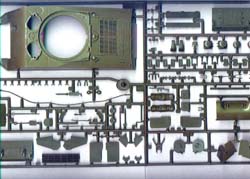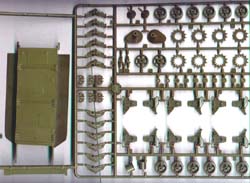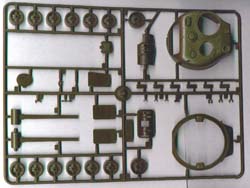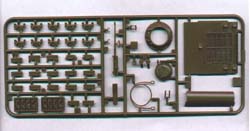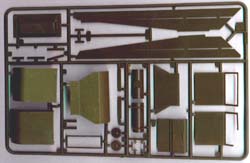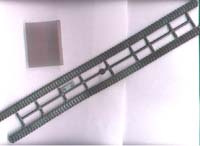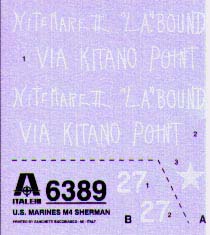ITALERI's 1/35 U.S. MARINES M4 SHERMAN
By Ray Mehlberger
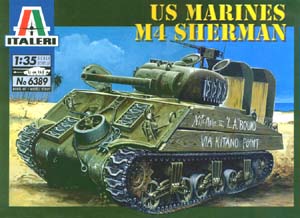 |
HISTORY
The "Sherman", U.S. medium tank, the M4 and variants were in U.S. service from 1942 until 1956, and in service with other countries even longer. A total of 49,234 Shermans were built in the U.S. during WWII, a quantity only equaled by one other wartime tank: the Soviet T-34.
When the M3 "General Grant" tank was adopted, in 1941, it was admittedly far from perfect, and as soon as production had been arranged work began on an improved model, much of which was based on British observations and requests based on their combat experiences.
The principal call was for a tank with a 75mm (2.95in.) gun, in a fully rotating turret, instead of in a side sponson as on the M3. Also, one which had a lower silhouette. The new design was originally known as the T6, and two alternative methods of manufacture were proposed: one was to have a cast upper hull, and the other to have a welded upper hull. The lower hull, engine, transmission, and running gear were to be based on the M3 components, so that, when the time came, production lines for the M3 could change to the new design with the least delay.
On December 11th, 1941 the two designs were standardized, the welded-hull model as the M4 and the cast-hull model as the M4A1, and production of the latter began in February 1942 on an assembly line already established by a British contract. The first two Shermans even bore British Army numbers; T25189 and T25190.
The basic Sherman had a turtleback hull shape, with a cast turret. The driver sat in the left front, with an assistant driver/machine gunner alongside him manning a flexable 0.30 in. (7.62mm) machine-gun; early models were provided with two additional fixed 0.30 in. machine-guns in the nose, but these were soon eliminated from the design. The engine was a radial, air-cooled aircraft type mounted in the rear of the hull, and the drive-shaft passed along the floor to the transmission unit in the nose, from where it drove the track drive sprockets. Suspension was by vertical valute spring suspension (VVSS) bogies, three two-wheeled bogies per side. The turret mounted a 75mm gun and a coaxial machine-gun and carried the gunner on the right, the commander behind him, and the loader/machine gunner on the left.
The principal variant models of the basic M4 can be listed as follows:
M4A1: As like the M4, but with the upper hull made as a one-piece casting and welded to the lower hull.
M4A2: As like the M4A1, but using twin GMC diesel engines.
M4A3: As like the M4, but using a Ford V-8 engine.
M4A4: As like the M4, but using a Chrysler multibank engine, built from five 6 cylinder engines arranged around a common crankcase. To accomodate the assembly the hull was lengthened by 28cm (11in.). Most M4A4 tanks were supplied to Britain, where they were known as the Sherman V.
M4A5: This designation was allocated to the Canadian "Ram" tank.
M4A6: An M4A4 with a Wright air-cooled radial engine converted from gasoline to diesel operation. After production commenced only 75 of these were built, following a decision to concentrate on gasoline engines.
There were also a large number sub-variants and scores of additional experimental types.
The most important variations came with armament. The original 75mm gun rapidly became obsolescent and better weapons were demanded. The British Army rapidly rearmed numbers of Shermans with their 17pdr. gun, calling the result the "Firefly". But, in spite of the lip-service being paid to the principal of "adoption of the best weapon, irrespective of nationality", the U.S. authorities refused to approve the 17pdr. and developed their own 76mm (3in.) gun instead. While better than the 75mm it was still no match for the German armor, and the Sherman was out-gunned for the last year of the war in Europe.
Another armament change was the adoption of the 105mm (4.1in.) howitzer M4 for the close-support role. This was a modification of the standard field artillery howitzer to make it a better fit into the turret and more convenient to operate. The ballistic performance of the howitzer remained unchanged.
A request for an assault tank, to accompany infantry, led to the M4A3E2 version (known as the "Easy 8"). This had an additional 36mm (1.5in.) of armor welded to the hull, and a new gun shield giving a total of 178mm (7in.) frontal protection to the turret and 152mm (6in.) side protection. This additional armor raised the weight to 42 tons, and reduced the speed slightly, but 254 were built and were used successfully in Europe.
Other variations included flame throwers, rocket launchers, mine exploders (flails), swimming apparatus (used principally in the Pacific Theatre---and subject of this new kit), and tank-dozer conversions.
The chassis of the Sherman formed the basis of a number of self-propelled guns. The first of these was the M7 "Priest", and this was followed by the M40 with its 155mm (6.1in.) gun. Though, in this case, the chassis was considerably altered from the standard. The 3in. (76mm) tank destroyer, M10, was one of the most successful Sherman conversions, though it did not reach it's full potential until it was re-gunned, first with the British 17pdr. and then with the U.S. 90mm (3.54in.) gun.
Sherman tanks remained in service, with the U.S. Army, throughout the Korean War until declared obsolete in 1956. They were widely supplied to other countries under various military aid schemes, and some of their most interesting service has been with the Israeli Army. Here the original Shermans were gradually modified, firstly by fitting the French, high velocity 75mm gun as used in the AMX-13 tank; this was known as the "Super Sherman". Later came the "Isherman" which successfully installed a 105mm gun into the turret and had the original engines replaced by a new Cummins diesel.
WHAT'S IN THE BOX?:
|
|

